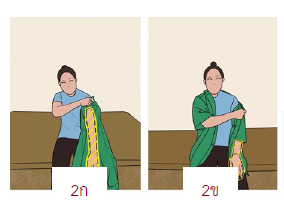Occupational Therapy for Frozen Shoulder
Main Article Content
Abstract
A frozen shoulder is a health issue caused by the smooth tissues of the shoulder capsule becoming inflamed and thickened. It can separate into 3 phases. Phase 1, the Painful or Freezing phase, is the phase that the pain affects the sleep cycle and makes the patient decrease in moving a shoulder joint which will lead the patient to Phase 2. Phase 2, Progressive stiffness or Frozen phase, the stiffness of the shoulder joint appears in this phase. It can reduce shoulder joint movement and affects the ability to perform the activities of daily living such as dressing and showering. Phase 3 is the Resolution or Thawing phase. Occupational therapy aims to release the pain and promote the patient to do the activities of daily living by advising bed positioning, advising posture when performing any activities by using the one-hand technique, selecting the assistive devices that help the patient to participate in the activities of daily living or environmental modification, and providing a home program for exercising. All these suggestions will help the patient in every phase of frozen shoulder to maintain their ability to perform the activities of daily living and have a better quality of life.
Article Details

This work is licensed under a Creative Commons Attribution-NonCommercial-NoDerivatives 4.0 International License.
References
von der Heyde RL. Occupational therapy interventions for shoulder conditions: A systematic review. Am J Occup Ther 2011;65:16-23.
Burner T, Abbott D, Huber K, Stout M, Fleming R, Wessel B, et al. Shoulder symptoms and function in geriatric patients. J Geriatr Phys Ther 2014;37:154-8.
ชยาภรณ์ โชติญาณวงษ์. ข้อไหล่ติด. [อินเตอร์เน็ต]. 2560. [เข้าถึงเมื่อ 2564 มิ.ย. 11]. เข้าถึงได้จาก https://www.si.mahidol.ac.th/sidoctor/e-pl/articledetail.asp?id=1283&word=%A2%E9%CD%E4%CB%C5%E8%B5%D4%B4
Hannafin JA, Strickland SM. Frozen Shoulder. Current Opinion in Orthopaedics 2000;11(4):271-5.
สุรศักดิ์ นิลกานุวงศ์ และ สุรวุฒิ ปรีชานนท์. ตำราโรคข้อ. พิมพ์ครั้งที่ 2. กรุงเทพ: เอสพีเอ็นการพิมพ์; 2548.
Lewis J. Frozen shoulder contracture syndrome - Aetiology, diagnosis and management. Manther 2015;20:2-9.
ณัฏฐิยา ตันติศิริวัฒ์. อาการปวดและความผิดปกติของข้อไหล่ที่พบบ่อยในเวชศาสตร์ฟื้นฟู. Chula Med J 2017;61(2): 205-21.
ธีรภัทร รักษาพล. ประสิทธิผลของโปรแกรมการออกกำลังกายเสริมความมั่นคงของข้อไหล่ร่วมกับการรักษาทางกายภาพแบบเดิม กับการรักษาทางกายภาพบำบัดแบบเดิมในผู้ป่วยข้อไหล่ติดของโรงพยาบาลนครศรีธรรมราช. Mahasarakham hospital journal. 2021;18(3):27-39.
Mertens MG, Meert L, Struyf F, Schwank A, Meeus M. Exercise Therapy Is Effective for Improvement in Range of Motion, Function, and Pain in Patients With Frozen Shoulder: A Systematic Review and Meta-analysis. Arch Phys Med Rehabil 2022;103:998-1012.e14.
พระราชบัญญัติการประกอบโรคศิลปะ (ฉบับที่ 4) พ.ศ. 2556. (2556, กุมภาพันธ์ 6). ราชกิจจานุเบกษา, เล่มที่ 130 ตอนที่ 13ก. หน้า 2.
Earley D, Shannon M. The Use of Occupation-Based Treatment With a Person Who Has Shoulder Adhesive Capsulitis: A Case Report. Am J Occup Ther 2006;60:397-403.
จีระนันท์ ระพิพงษ์. การออกกำลังกายเพื่อการบำบัดรักษา. [อินเทอร์เน็ต]. 2561. [เข้าถึงเมื่อ 2565 ต.ค.29]. เข้าถึงได้จาก https://w1.med.cmu.ac.th/rehab/images/Study_guide/08_1MSKExercise_JR.pdf
Mertens MG, Meeus M, Verborgt O, Vermeulen EHM, Schuitemaker R, Hekman KMC, et al. An overview of effective and potential new conservative interventions in patients with frozen shoulder. Rheumatol Int 2022;42:925-36.
Marik TL, Roll SC. Effectiveness of occupational therapy interventions for musculoskeletal shoulder conditions: A systematic review. Am J Occup Ther 2017;71(1):7101180020.






